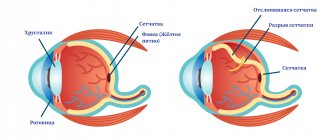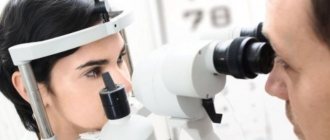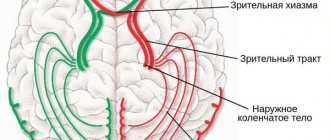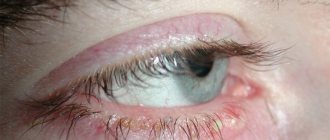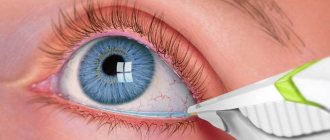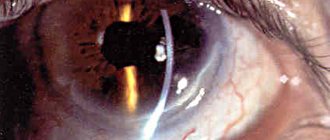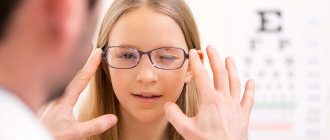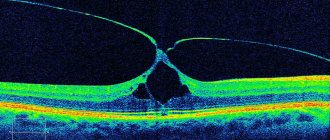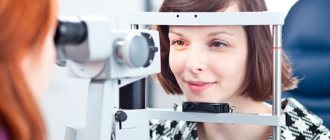Surgery for strabismus in adults is used in the following situations:
- as part of complex treatment for correcting the angle of strabismus - as a preparatory stage before pleopto-orthoptic treatment;
- if conservative treatment methods are ineffective - to eliminate a cosmetic defect.
The purpose of surgery to correct strabismus is to correct the length of the extraocular muscles:
- Shortening – allows you to enhance muscle function. It is achieved by methods of resection of a muscle section, creating a fold in the tendon area (tenorrhaphy), moving the point of muscle fixation (anteposition).
- Lengthening - weakens the function of the muscle that “pulls” the eyeball towards itself. It is achieved through the following operations: dosed dissection of muscle fibers, as well as anteposition (movement closer to the cornea).
Progress of the operation
Surgical intervention to correct strabismus often requires preparation in the form of orthoptic exercises using the Synoptophore ophthalmological device. Their goal is to eliminate physiological disorders of visual functions characteristic of strabismus. Depending on the complexity of the case, preparation can last from two weeks to six months.
Surgery involves the use of general anesthesia for children and local anesthesia for adults. After it begins to act, the eyelids are fixed with a special dilator to prevent involuntary blinking. The course of the operation is as follows:
- incision of the sclera, conjunctiva in order to open access to the muscles;
- pulling the muscle out, cutting it or suturing it in accordance with the patient’s indications;
- suturing and bandaging.
If necessary, the operation can be performed under a microscope. The blindfold is removed the next day. While the anesthesia is in effect, the patient remains under the supervision of medical personnel. After this, if he feels well and no complications are observed, he is sent home.
Diagnostics
The diagnosis of strabismus is made based on a detailed clinical examination.
The ophthalmologist evaluates the parallelism of the visual axes of the eyes, the mobility of the eyeballs, visual acuity in each eye, determines binocularity of vision, conducts special tests and ophthalmoscopy. If the diagnosis of strabismus is made in adulthood, it is necessary to find out its cause. It is often necessary to conduct a neurological examination to determine the condition of the brain structures.
Types of operations
Surgical treatment is aimed at normalizing the functioning of the muscles of the eyeball. The surgeon either loosens a tense extraocular muscle or strengthens a relaxed one. Therefore, there are two types of operations for strabismus:
- Weakening. Examples include recession (cutting and grafting the muscle further away from the cornea), partial myotomy (cutting part of the tissue), and muscleplasty (lengthening the fiber).
- Strengthening. This type of correction allows you to eliminate strabismus by shortening the muscle without changing its place of fixation.
Sometimes there is a need to treat both eyes or a combination of two types of intervention. Then the operation is carried out in stages, with an interval of 6-8 months.
The decision to choose one or another type of surgical treatment is made by an ophthalmologist, taking into account several factors:
- patient's age;
- nuances of muscle fiber fixation;
- angle of strabismus;
- the nature of the movement of the eyeball;
- general condition of the body, etc.
To achieve maximum treatment results, ophthalmological surgeons adhere to certain principles in their work. Thus, excessive haste and one-stage surgical intervention do not always provide the desired effect. Therefore, if indicated, correction of strabismus is carried out in several stages. An important point is the uniform distribution of the load and alignment of the position of the visual organs. During the operation, there must be a connection between the muscle and the eyeball.
Causes
The causes of congenital strabismus lie in the prenatal period.
Acquired strabismus occurs as a result of the following conditions:
- a significant decrease in vision in one eye, as a result of which the image from its retina is not projected into the central nervous system, the brain gradually stops using this eye altogether as unnecessary,
- damage to the oculomotor nerves as a result of infections, injuries, neoplasms, hemorrhages, systemic diseases (diabetes mellitus),
- damage to the oculomotor muscles as a result of trauma, myasthenia gravis,
- functional impairment as a result of stress, fear, mental disorders (conversion disorder).
Features of surgical correction of strabismus in people of different ages
Surgery in children
Children under 18 years of age undergo surgical treatment using the classical method and under general anesthesia. The duration of hospitalization is determined by the attending physician and can be extended depending on the condition of the child. Eliminating strabismus in children takes a lot of time and requires careful adherence to all recommendations and constant monitoring by an ophthalmologist. In addition to surgical correction, a prerequisite for achieving the best effect is wearing glasses and strictly following all other medical recommendations.
Surgery for strabismus in adults
Correction of strabismus in adults occurs under local anesthesia, and the patient can leave the medical facility the next day after the operation.
The CELT clinic successfully uses a unique method of adjustable sutures.
Compared to the classic one, it allows you to more accurately dose the effect of the operation. This is especially true for adult patients who are concerned about the unsatisfactory results of surgical treatment performed in childhood. This method perfectly corrects all existing external flaws.
What is strabismus and why does it occur?
In order to understand the specifics of strabismus, you need to understand what the normal functioning of the visual organs is. Both eyes have a certain number of muscles - six in each. By working together, they provide eye movement. All twelve muscles are under the control of the brain, which is responsible for ensuring that both eyes look in the right direction. The coordination of all twelve muscles helps to combine the two images into one. When we look at the world with our eyes, both eyes work independently and perceive everything separately. And in the brain the whole picture merges together - this is binocular vision. At birth, a child does not yet know how to see with both eyes. The ability for binocular vision develops gradually and lasts until four to six years. Since it occurs gradually, it can be easily disrupted. All newborns have farsightedness of about three diopters. In this case, the focus does not fall on the retina, but is located behind it. As the child grows, the eyeball increases in size and the optical focus moves to the retina. Some children, for various reasons, have farsightedness greater than three diopters. To see objects clearly, they have to strain their eyes. This tension is often the main prerequisite for the occurrence of convergent strabismus.
The essence of strabismus is that the child’s eyes take a position in which their axes do not converge on the object in question, as should be normal, but deviate to the right, left, or up or down (but this phenomenon is observed less frequently). If the squinting eye is facing the temple, the strabismus is considered divergent, and if it is towards the nose, it is considered convergent.
In its origin, strabismus can be congenital - in this case, the baby is already born with problem eyes, or acquired, most often in early childhood.
There are many causes of strabismus; each specific case must be examined individually with a pediatric ophthalmologist.
Some children develop strabismus due to weakness of the eye muscles. Or because of farsightedness and myopia: the baby has difficulty seeing objects located close or far away, so he strains his eyes, which over time can lead to illness. Sometimes strabismus develops as a result of astigmatism (uneven curvature of the cornea or lens) and as a result of a violation of the focusing of the image of an object on the retina, due to which the child sees everything in a distorted form.
The formation of strabismus can be caused by neurological diseases and abnormalities, severe stress and psychological trauma of the child, fetal intoxication, trauma, decreased vision of one or both eyes due to various diseases (congenital cataracts, retinal dystrophies).
The factor of heredity also plays a significant role: if parents “mow,” there is a high probability that their children will encounter this problem. Congenital strabismus can also be caused by diseases of the expectant mother.
Treatment effectiveness
Indeed, the surgical method of correcting strabismus eliminates all external problems associated with this disease. But the final restoration of visual functions requires some patience and time. Subsequent conservative therapy is aimed at combating amblyopia that accompanies strabismus and the formation of binocular vision (the ability to perceive images with two eyes simultaneously).
The postoperative rehabilitation period lasts only a week, while restoration of visual function takes, on average, up to two years.
The success of treatment depends on many factors. Thus, the right choice of clinic and experienced ophthalmologists are its main determining factors. The CELT clinic meets all necessary criteria and standards for the quality of medical care. The high professionalism of doctors, modern equipment and comfortable living conditions create all the necessary conditions for a complete cure of the disease.
Exercises for strabismus
I would like to note that treating strabismus without surgery is a long journey of several months and even years. But with the right approach and following all the doctor’s instructions, you can completely get rid of this disease. The most effective thing is to strengthen the eye muscles with the help of special exercises.
- Stand up straight and extend your hand in front of you. Focus on one finger. Then you need to slowly bring your finger to your face, and then slowly move it back. The head is motionless, only the pupils follow one point. After that, move your finger left, right, up and down. Repeat each movement 5 times.
- Stand by the window and stick a picture with bright colors on the glass. Look at the picture at arm's length. Then look at the antenna of a neighboring house or any other object in the distance. After 30 seconds, look at the picture again. This way you focus your vision on far and near objects, this is an excellent exercise for training the eye muscles. Separately, the exercise can be done with one sore eye.
- The next exercise is figure eight. You need to draw a huge figure eight in front of you with your pupils. Movements should be smooth, try not to cut corners. After this, try to make an inverted figure eight - an infinity sign. Do the exercise slowly and carefully.
- Have you been to the tennis court? This is a great place to train your eyesight. Constantly changing the position of the ball forces you to move your eyes from side to side. Instead of tennis, any ball games are suitable - volleyball or basketball. You can watch the game or participate in it - it is equally beneficial for your eyesight.
- Train the eye that squints. Cover the healthy eye with a bandage and try to look with the affected eye in the direction where it does not want to turn. Look at a bright object with at least peripheral vision, train an undeveloped muscle.
- If you encounter strabismus in a young child, he will not be able to consciously perform eye exercises. Therefore, show him colorful images that should be placed to the right and left of him. Constantly ask, “Where is the bird?”, “Where is the ant?”, so that the child involuntarily trains his eye muscles by looking up and down.
Patient daily work will help restore the sore eye. Regular exercise will make you not only healthy, but also a confident person. This is evidenced by the huge number of positive reviews from people who have overcome this disease. Be healthy and happy!
how to relieve eye redness using folk remedies
Reviews of doctors providing the service - Surgery to correct strabismus
When illness strikes, it is very important to find a highly qualified, caring doctor.
Tatyana Igorevna is exactly such a doctor! Behind each of her recommendations is enormous knowledge and experience, as well as respect for the patient’s personality. This is what gives hope for the best! THANK YOU. Read full review Svetlana
06.09.2019
Vladimir Yuryevich Makhmutov is a doctor of rare talent. Out of this world! Talent, kindness, courtesy, attentiveness. Skillful fingers. Many thanks and low bow. Shchedrova E. Read full review
Shchedrova Ekaterina
25.03.2019
The role of chocolate in the treatment of strabismus
Chocolate contains a special substance that helps strengthen the eye muscles. It is impossible to cure strabismus by simply including chocolate in your diet. However, in complex therapy this is an excellent help. Let your child eat 4 pieces of chocolate every time after the main meal (breakfast, lunch and dinner) to achieve a therapeutic effect. Adults can increase the dosage by 2-3 slices. This will be the most delicious medicine.
Attention! Only real, dark chocolate is suitable for the treatment of strabismus. It is also called dark. It must contain at least 60% cocoa powder.
Traditional methods of treating strabismus
To strengthen the eye muscles, it is useful to take herbal infusions and decoctions. Their effectiveness in treating strabismus was known in ancient times.
Calamus root
Brew dried calamus roots (10 g) with a glass of boiling water (200 ml). Then place in a water bath and keep there for 10-15 minutes. Then let the broth cool. Strain it. Drink 50 ml of decoction 30 minutes before each meal (with three meals a day).
Cabbage
Cabbage leaves are very beneficial for the eyes. You need to boil several leaves daily (until completely softened) and eat them with the water in which they were prepared.
Rose hip
This remedy is very healthy and tasty. Moreover, you can drink it in almost unlimited quantities. To prepare, take 100 grams of dried berries and 1 liter of water. Boil the fruit drink over low heat. Remove from the stove and let it brew for at least 5 hours (it’s better to cook in the evening and leave overnight). Now strain the rosehip decoction and drink it throughout the day. Add honey for good taste.
Pine
Pour boiling water over the pine needles and let it brew. You can choose the proportions yourself, since this product is not for everybody. Drink 1 tablespoon of infusion every time after meals.
Chinese lemongrass
This product should not be used by children as it is an alcohol tincture. A bottle of vodka (500 ml) will require 0.1 kg of Chinese lemongrass berries. They are finely chopped and filled with vodka. For 10 days, the mixture is infused in a closed glass container in a dark place at room temperature. Shake the container several times throughout the day.
Take the prepared tincture twice a day with meals. To do this, dilute 20 drops of tincture in water.
Homemade eye drops
You can try natural drops. We offer you two options:
- Brew 5 g of dill seeds (pre-dried) in 100 ml of boiling water. Let it brew and cool. Then strain (there should not even be small particles left in the dill tea). Place the infusion three times a day in each eye, 2 drops.
- Squeeze the juice from apples and onions, prepare fresh honey (candied honey will not work). Take 1 part onion juice, 3 parts apple juice and another 3 parts honey. Mix the ingredients together. Bury the composition every day before going to bed, 1-2 drops. Store the product in the refrigerator.
Strabismus can be successfully treated at home if it has not yet caused vision impairment. You can combine the therapy recommended by your doctor with the treatment methods you learned about in this article. In any case, delicious rose hip juice, real chocolate and simple exercises are not only a step towards recovery, but also a pleasant pastime.
